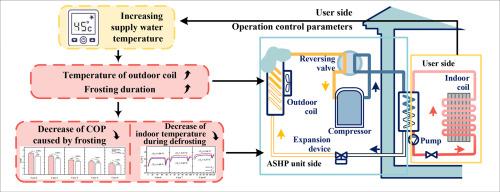Effect of supply water temperature on frosting performance of air source heat pump and indoor thermal environment in space heating
IF 7.1
1区 工程技术
Q1 CONSTRUCTION & BUILDING TECHNOLOGY
引用次数: 0
Abstract
During the space heating in winter, the air source heat pump (ASHP) often encounters frosting problem. In former studies, it was found that the frosting performance of ASHP and indoor thermal environment vary significantly when the supply water temperature changes. However, the influence mechanism of supply water temperature is still unknown. To solve this problem, the frosting performance variations of ASHP and its effect on indoor thermal environment variations at the supply water temperature of 41–50 ℃ were investigated in the psychrometric chamber and artificial environmental chamber, respectively. Results showed that increasing supply water temperature can effectively suppress the frosting speed and reduce the impact of frosting-defrosting on indoor thermal environment. When the supply water temperature raises from 30 ℃ to 50 ℃, the frosting duration prolongs from 50 min to 101 min. Meanwhile, the indoor temperature drop caused by frosting-defrosting decreased by about 45 % when supply water temperature rises from 41 ℃ to 50 ℃. Besides, with the increase of supply water temperature, the impact of frosting on the heating performance of the ASHP decreases. When it rises from 30 ℃ to 50 ℃, the attenuation degree of the average coefficient of performance during frosting-defrosting cycle drops from 9.85 % to 7.25 %, compared to those at non-frosting condition. However, although the frosting performance of ASHP and its effect on indoor thermal environment both get better with the increase of supply water temperature, the overall heating performance of the ASHP still declines.

供水温度对空气源热泵结霜性能和空间供暖室内热环境的影响
在冬季空间供暖过程中,空气源热泵(ASHP)经常会遇到结霜问题。以往的研究发现,当供水温度变化时,ASHP 的结霜性能和室内热环境会发生显著变化。然而,供水温度的影响机制尚不清楚。为了解决这个问题,我们分别在心率室和人工环境室中研究了供水温度为 41-50 ℃ 时 ASHP 的结霜性能变化及其对室内热环境变化的影响。结果表明,提高供水温度可有效抑制结霜速度,减少结霜-化霜对室内热环境的影响。当供水温度从 30 ℃ 升至 50 ℃ 时,结霜持续时间从 50 分钟延长至 101 分钟。同时,当供水温度从 41 ℃ 升至 50 ℃ 时,结霜-除霜引起的室内温度下降约为 45%。此外,随着供水温度的升高,结霜对 ASHP 制热性能的影响也会减小。当供水温度从 30 ℃ 升至 50 ℃ 时,与不结霜条件下相比,结霜-化霜循环期间平均性能系数的衰减程度从 9.85 % 降至 7.25 %。然而,虽然 ASHP 的结霜性能和对室内热环境的影响都随着供水温度的升高而改善,但 ASHP 的整体供热性能仍在下降。
本文章由计算机程序翻译,如有差异,请以英文原文为准。
求助全文
约1分钟内获得全文
求助全文
来源期刊

Building and Environment
工程技术-工程:环境
CiteScore
12.50
自引率
23.00%
发文量
1130
审稿时长
27 days
期刊介绍:
Building and Environment, an international journal, is dedicated to publishing original research papers, comprehensive review articles, editorials, and short communications in the fields of building science, urban physics, and human interaction with the indoor and outdoor built environment. The journal emphasizes innovative technologies and knowledge verified through measurement and analysis. It covers environmental performance across various spatial scales, from cities and communities to buildings and systems, fostering collaborative, multi-disciplinary research with broader significance.
 求助内容:
求助内容: 应助结果提醒方式:
应助结果提醒方式:


